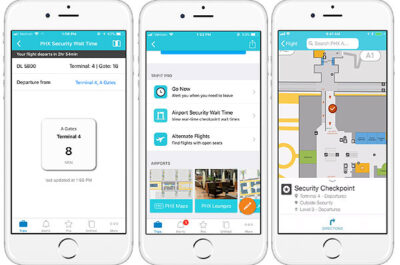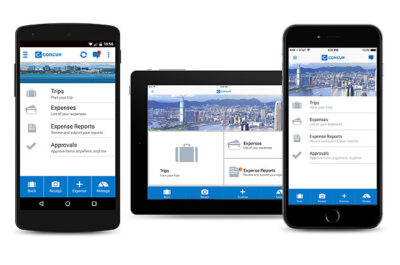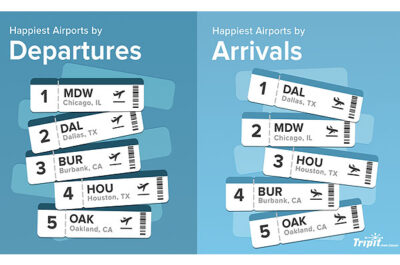Access to spending insights, negotiating power and mobile tools key to managing expenses for businesses of all sizes.
BELLEVUE, WASH. – Concur released its Concur Expense IQ Report, the company’s third annual global report analyzing more than $50 billion in corporate travel and entertainment (T&E) spend. Leveraging expense data generated by its more than 18,000 corporate clients, this report provides businesses with unique insight to help inform their travel and expense programs.
The Expense IQ Report uncovers that per quarter small to mid-market businesses (SMB) traveled more often than their large market counterparts, purchasing more air tickets (37 percent), meals (29 percent) and rental cars (65 percent). However, SMB travelers filed nine percent fewer lodging transactions per quarter than enterprise travelers.
The Concur Expense IQ Report uncovers differences between SMB and large companies, including the fact that SMB travelers spent more on average per quarter in 2012 for T&E expenses in every major category, including:
- Airfare (14 percent)
- Dining (18 percent)
- Lodging (21 percent)
- Car Rental (57 percent)
“The second-largest controllable spend for most companies is T&E – making visibility into this area mission critical. The Concur Expense IQ Report is designed to do just that,” said Robson Grieve, Executive Vice President of Worldwide Marketing for Concur. “For instance, our data shows us that SMBs are more active on average than large market companies due to the fact they file expense transactions nearly 17 percent more frequently and spend almost 25 percent more on the road. This underscores the importance of deeper insight and analysis into T&E spend to negotiate better prices, manage expense policies and improve efficiencies.”
The Concur Expense IQ Report also finds corporate travelers spent 93 percent more on ancillary fees such as baggage and onboard entertainment, in 2012 ($58 million) than they did in 2011 ($30 million) – challenging companies with nearly twice as much hidden or low-visibility spend.
“The fact that ancillary spending nearly doubled from 2011 to 2012 reflects two key facts: customers are using automated tools to more accurately track their ancillary spending, while airlines, hotels and other providers have gotten more savvy about componentizing their services to collect more cash in a down market,” explained Robert Mahowald, VP of Cloud Services at IDC.
Concur found that despite paying more for airline-related products and services, companies still spent 4.5 percent less overall, per traveler, per quarter, in 2012 than they did in 2011. A key reason for this was a significant drop in fourth-quarter spending.
“While 2012 was generally a year of tighter budgets for U.S. travelers, the sudden and extreme decline in Q4 T&E spend in particular is a bit of an outlier,” according to Mahowald. “The dip is likely due to a set of exogenous macro-economic events, such as the impact of Hurricane Sandy, uncertainty about the U.S. presidential election in November, and the “fiscal cliff” negotiations that extended into the first days of 2013, rather than any broad corporate efforts to cut back on T&E spend.”
Other key findings from the report include:
- In 2012, the average expense report filer spent $3,244 per quarter on T&E
- Concur found spending in almost all expense types declined at least slightly, including dining (-11.1 percent), car rental (-9.1 percent), and airfare (-8.2 percent); hotel spending dropped the least (-3.8 percent)
- Hotel spending accounted for the highest share (24 percent) of all international spend, while airfare expenses accounted for the highest share of all U.S. spend
- The most expensive international city for business travel was Brisbane, Australia, followed by Tokyo, Japan and Sydney, Australia
- The most expensive U.S. cities for business travel in 2012 were New York City, NY; San Francisco, CA; Garden City, NY; Washington, D.C.; Boston, MA; Long Island, NY; Chicago, IL; Miami, FL; Las Vegas, NV and Santa Clara, CA
Desire for Mobile Expense Reports Growing
Mobile devices were also found to be a growing aspect of companies’ expense management processes as logins to the Concur mobile expense app more than tripled from 2011 to 2012. The study found nearly 73 percent of these logins were via Apple iOS, while Android (14.6 percent) and Blackberry (12.7 percent) were also popular.
“We’ve seen great momentum around Concur’s mobile application this past year among businesses of all sizes,” Grieve said. “Understanding that travel is inherently mobile, it’s easy to see how using a tool that moves with business travelers wherever they go increases productivity – whether it’s billable work or something more administrative like managing expenses.”
Tatiana is the news coordinator for TravelDailyNews Media Network (traveldailynews.gr, traveldailynews.com and traveldailynews.asia). Her role includes monitoring the hundreds of news sources of TravelDailyNews Media Network and skimming the most important according to our strategy.
She holds a Bachelor's degree in Communication & Mass Media from Panteion University of Political & Social Studies of Athens and she has been editor and editor-in-chief in various economic magazines and newspapers.



























































































































































































